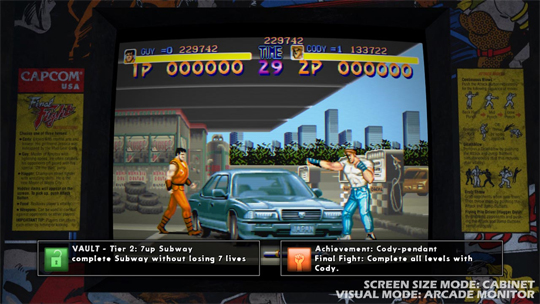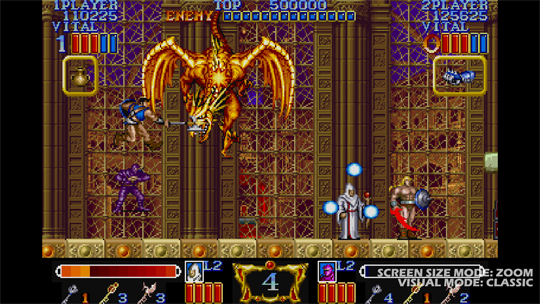Some classic games are best left in the past, never to be heard from again. The pair of side-scrolling action titles in Capcom’s Final Fight: Double Impact are not that type of game at all; with this downloadable double pack, old-school fans will love to revisit Final Fight and Magic Sword, and newcomers will get a glimpse of early-90s awesomeness without the usual downers associated with arcade cabinets, and with some added features for the online gaming era.
The two games are represented in-game as virtual arcade cabinets, and players can either go solo, create a local or online multiplayer game, or simply drop into an existing session with a random partner. There’s also an option to search for games that meet specific progress and difficulty criteria before jumping in. Along with online leaderboards, achievements/trophies, remastered music, and multiple display options to accommodate both arcade purists and HD gamers alike, these updates make Final Fight: Double Impact more than just a flashy, two-game emulator, and a viable purchase at ten dollars for PS3 and Xbox 360 owners.
No matter what the packaging, though, it really comes down to the games, and the two included here are rock solid.

Final Fight is one of the most acclaimed beat-em-up titles of all time, and a standard by which many later games in the genre have been measured. Mayor Mike Haggar’s daughter is kidnapped, as required by the late-80s/early-90s beat-em-up bylaws, and he, Cody, and Guy beat the crap out of every thug in Metro City until she is safe. These three heroes cover the big-and-strong, “Arnold Schwarzenegger,” small-and-quick, “Bruce Lee,” and somewhere-in-the-middle, “Jean-Claude Van Damme” archetypes and each have a distinct feel about them. In fact, much of what makes Final Fight so effective is the way players can feel every punch, kick, axe handle, throw, suplex, piledriver, and of course, spinning lariat.
Even with a simple two-button control scheme, pummeling the colorful cast of lowlifes never seems to lose its appeal, but Double Impact doesn’t think twice about reminding players just how difficult that can be. This is the arcade version of the game, which was obviously designed to rob kids of their hard-earned allowances. That means that the difficulty is not scaled back like in the SNES port, and players will be surrounded by mobs of knife-wielding maniacs, bull-charging fat men, and Andre the Giant lookalikes all the time, not to mention the game’s six tough bosses residing in each area. Luckily, players have unlimited continues this time around, like an endless stream of quarters keeping Haggar and company fighting until the very end. Some might consider that a flaw because it removes the tension of the original arcade game, makes this reproduction far more beatable than ever before, and shortens the duration of a single playthrough. Final Fight is indeed a short game, but if replaying it hasn’t gotten old in 21 years, I don’t think it’s going to anytime soon, especially with Double Impact‘s enhanced co-op component.

The other game, Magic Sword, may be less of a household name than Final Fight, but is just as enjoyable to play. This side-scroller takes place in a fantasy world where players take control of a barbarian known only as “The Brave One,” and must battle to the top of the 51-floor Dragon Keep to destroy the evil Drokmar. Eight cpu-controlled allies can join The Brave One on his quest, but only after being rescued from prison cells and only one at a time. These warriors run the traditional fantasy gamut — knight, thief, priest, wizard, amazon, ninja, etc. — and each have unique skills and attacks specific to their class standard. Enemies are varied and plentiful, as well, including eight boss characters, although strategy generally remains the same throughout the adventure; it’s straightforward hack-n-slash all the way.
The size of Magic Sword is impressive for an arcade side-scroller from 1990, and will provide players with more novel playing time than Final Fight. Even with a number of secret paths that allow The Brave One and company to bypass multiple floors at once, making it to the top will take some time, and is the most likely reason for players to employ Double Impact’s option to save either game at any point. The diversity of characters and character abilities, and constantly swapping them out for one another throughout the game is a particularly captivating aspect of Magic Sword, and the lesson that treasure chests don’t necessarily require keys, but will respond just as well to tempered steel is always entertaining.
The two games included in Final Fight: Double Impact are both 20 years old, but still manage to carry the same appeal as when they were first introduced. Of course the technology behind video games has advanced since 1989, so one can’t expect ultimate control precision or impressively complex AI routines, but for classic arcade fun, Final Fight and Magic Sword both deliver, especially when played with a friend. A solid remake, for sure.

















